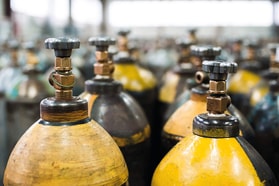Electronic gases – chips with everything
Semiconductor manufacturing, and its close cousin, the production of liquid crystal display (LCD) screens, is a complicated business, with more than a hundred process steps and over 30 different process gases used for etching, deposition, oxidation, doping and inerting along the way. For the manufacturers, having a reliable supply of high purity gases is critical.
The gas companies themselves have seen the electronics industry as a huge opportunity for them in the past 15 years, and you will normally see gas companies represented at SemiCon events around the world. There are four elements that make up the electronics gases sector: high purity core gases, electronics gases, services and equipment. The major industrial gas companies have, in general, participated in the former and more recently in the latter.
What Constitutes an Electronic Gas/strong>
High purity air gases play a key role and the need has grown for these to be classified as ultra-high purity (5 or 6 nines purity). For example, nitrogen is used as an inerting atmosphere or as a carrier for reactive agents. Oxygen is used in the oxidation of silicon. Argon is used in applications requiring a more inert environment (nitrogen would react to form metal nitrides). Hydrogen is used to provide a reducing atmosphere in the annealing of metal films and supercritical CO2 is gaining ground as a useful solvent in various processes. And that’s just for starters.
In other stages of the manufacturing process, a wide range of manufactured gases (classified as electronic gases) are used. For example, gases such as silane, dichlorosilane and trichlorosilane are used in processes such as epitaxy in and chemical vapour deposition (CVD) to deposit layers of silicon directly onto the single crystal silicon substrate. Others such as arsine, phosphine and boron trifluoride are used as dopants to modify the local electrical properties of the semiconductor material. The etching process relies on inert fluorocarbons such as carbon tetrafluoride (Halocarbon R14), trifluoromethane (R23) and hexafluoroethane (R116) and nitrogen trifluoride. These are used on various layers during a process known as plasma etching.
In semiconductor fabs, where cleanliness is next to godliness and absolutely essential for the success of the manufacturing process, gases also play an important role. Gases such as perfluorocarbon, which is implicated in global warming, were often used to remove any contaminants or stray molecules from CVD chambers. But now the more environmental friendly gas, fluorine (F2), is preferred. This can be supplied in high pressure cylinders, but companies such as The Linde Group (www.linde.com/electronics) now offer packaged on-site fluorine generators providing an alternative for the safe and reliable supply of F2 to semiconductor and LCD processes.
Liquid assets?/strong>
A big debate in the semiconductor industry centres on whether to use liquids rather than gases to deposit the layers onto the silicon substrate. Some manufacturers believe that its easier to control the deposition process when liquid chemicals are used. But, argues Colin Overton, gases sales manager at Epichem (www.epichem.co.uk), as chips get smaller and the layers get thinner, the use of gases offers semiconductor manufacturers a number of advantages, particularly when it comes to growing and processing chips where the layers are much less than a micron thick. Although there are some disadvantages associated with the use of gases – they tend to be more expensive, difficult to handle, some are highly toxic, and others are even pyrophoric and potentially explosive if safety procedures are not rigorously applied – there are still many advantages to their use.
For example, gases flow into and out of the reactor easily, and any remaining gas can be purged out using an inert gas such as nitrogen and argon. It is also easier to control the amounts of dopants deposited using a gas, and unlike liquids, gases leave no residue behind when they evaporate. Gases are also able to flow into the microscopic features – or vias – in chips, where surface tension would restrict the flow of a liquid. The use of gases also makes it possible to operate the reactors at lower temperatures.
‘We’re convinced that gases will continue to play a key role in semiconductor manufacture for a long time to come’, says Noel Leeson, President, Linde Electronics based in Hong Kong, ‘and predict a rapidly increasing demand for ultra high purity gases for the semiconductor and optoelectronic industries with eastern China emerging as the technology hot spot. Having recently invested more $20 million in a new electronics gases facility in Suzhou Industrial Park in China’s Jiangsu province, we look forward to serving this growing market.’
Organometallics: markets for volatiles/strong>
But gases on their own are not the only answer in some manufacturing processes. For some types of chip, such as the very high frequency gallium arsenide chips used in mobile phones or the indium phosphide chips used in fibre optic communications, volatile liquids – known as organometallics or metal organics – are the only way to deposit layers of the correct composition. Although they come in liquid form, the organometallics are volatile and do the job of a gas. They are dispensed using a bubbler, where a carrier gas bubbled through the liquid picks up the molecules and carries them into the flow reactor. Improvements in the packaging of organometallics – such as the introduction of sensors to detect how much product is left in the bubbler without having to disconnect it from the process stream – are making them easier to incorporate into the manufacturing process.
With the growing use of organometallics, comes the potential for developing new and more exotic molecules with properties tailored to fulfil specific roles in the chip structure or in the manufacturing process. ‘The demands on chips are now so great that silicon – either pure silicon, silicon oxide or doped silicon – is not always the answer,’ says Overton. ‘We are being asked for more and more weird and wonderful organometallics based on transition metals for use as nitride and oxide precursors.’ Organometallics using the III-V materials, such as gallium arsenide are also in demand for manufacturing light emitting diodes (LEDs). The challenges faced by companies like Epichem, Overton notes, are to produce new materials, as well as purer and purer materials.
... to continue reading you must be subscribed









